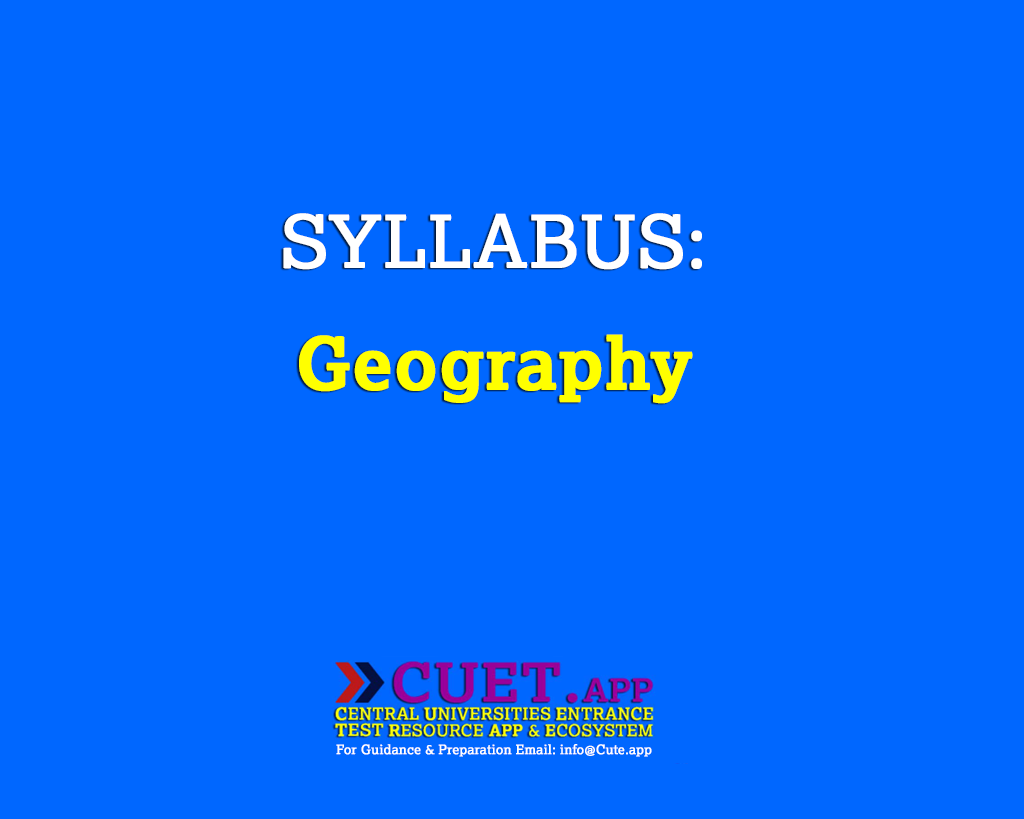Syllabus | Geography for Common University Entrance Test CUET (UG) – 2022
GEOGRAPHY/GEOLOGY | SYLLABUS FOR CLASS 12
Note: There will be one Question Paper which will have 50 questions out of which 40 questions need to be attempted.
Fundamentals of Human Geography
Unit I: Human Geography
Human Geography: Nature and Scope
Unit II: People
• Population of the world – distribution, density and growth;
• Population change – spatial patterns and structure; determinants of population change;
• Age-Sex ratio; rural-urban composition;
• Human Development – concept; selected indicators, international comparisons.
Unit III: Human Activities
• Primary activities – concept and changing trends; gathering, pastoral, mining, subsistence agriculture, modern agriculture; people engaged in agriculture and allied activities – some examples from selected countries;
• Secondary activities – concept; manufacturing: agro-processing, household, small scale, large scale; people engaged in secondary activities – some examples from selected countries;
• Tertiary activities – concept; trade, transport and communication; services; people engaged in tertiary activities – some examples from selected countries;
• Quaternary activities – concept; knowledge based industries; people engaged in quaternary activities – some examples from selected countries.
Unit IV: Transport, Communication and Trade
• Land transport – roads, railways – rail network; trans-continental railways;
• Water transport- inland waterways; major ocean routes;
• Air transport – Intercontinental air routes;
• Oil and Gas pipelines;
• Satellite Communication and cyber space;
• International trade – Basis and changing patterns; ports as gateways of international trade, role of WTO in International trade.
Unit V: Human Settlements
Settlement types – rural and urban; morphology of cities (case study); distribution of mega cities; problems of human settlements in developing countries
India: People and Economy
Unit I: People
• Migration: international, national – causes and consequences;
• Human Development – selected indicators and regional patterns;
• Population, Environment and development.
Unit II: Human Settlements
- Rural settlements – types and distribution;
- Urban settlements – types, distribution and functional classification
Unit III: Resources and Development (Periods 30)
Land resources – general land use; agricultural land use – major crops; agricultural development and problems, common property resources;
• Water resources – availability and utilization – irrigation, domestic, industrial and other uses; scarcity of water and conservation methods – rain water harvesting and watershed management (one case study related with participatory watershed management to be introduced) ;
• Mineral and energy resources – metallic and non-metallic minerals and their distribution; conventional and non-conventional energy sources;
• Industries – types and distribution; industrial location and clustering; changing pattern of selected industries – iron and steel, cotton textiles, sugar, petrochemicals, and knowledge based industries; impact of liberalisation, privatisation and globalisation on industrial location;
• Planning in India – target area planning (case study); idea of sustainable development(case study).
Unit IV: Transport, Communication and International Trade
Transport and communication — roads, railways, waterways and airways; oil and gas pipelines; national electric grids; communication networkings – radio, television, satellite and internet;
• International trade — changing pattern of India’s foreign trade; sea ports and their hinterland and airports.
Unit V: Geographical Perspective on Selected Issues and Problems
• Environmental pollution; urban-waste disposal;
• Urbanisation: Rural-urban migration; problem of slums;
• Land Degradation.


